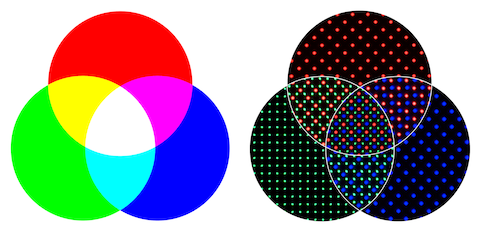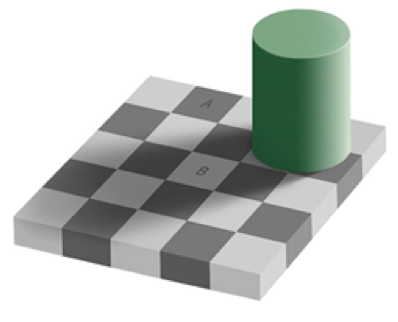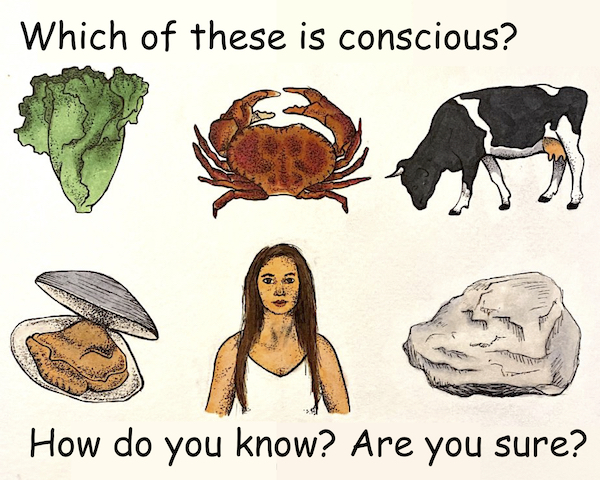The way you perceive colors directly impacts the choices you make in your everyday life. From the packaging of food, to the apps we use for music, to the cinematography in a movie—colors dictate what we buy, what we click on, and even what we feel. The human response to color is an evolutionary remnant from when choosing between eating a green leaf and a red one could mean life or death. In ‘A History of Color,’ we delved into the contributions that both scientists and artists have made to our understanding of color. Now, we’ll investigate how humans perceive the colors around us. We’ll also highlight current knowledge of computer color perception, such as that used in artificial intelligence, and its limitations compared to humans.
If you are like most people, you have the ability to detect minute changes in value and saturation within colors, whether they are from pigment or light. Within the human retina are over 100 million photoreceptors that are intrinsic to perception of colors: rods and cones. Rods are capable of discerning differences between black and white, creating a grayscale spectrum and delineating the saturation levels in colors. They are also responsible for perception of size and shape, and help you see in low-light conditions. Cones allow for color and detail perception, and are split into three different groups, which pick up red light, green light, and blue light. Then why can’t humans see in only blue, red, and green?
Isaac Newton’s discovery of primary colors gave rise to the trichromatic theory of color vision, which stipulates that color vision is based on the level of activation of different primary cones. For example, if we see yellow, it is because our red and green cones are being activated. When all three cones are activated equally, we get grayscale vision.
The trichromatic theory suggests that color vision is based on additive processes. Additive colors are those that are produced by the mixing of light against a dark template; one color added to another will yield a new color different from the previous two. For example, computer images are composed of individual color pixels, produced by mixing the primary colors blue, red, and green. The computer is capable of making 256 variations in value of these three colors, for a total of 256^3 or 16,777,216 colors! So whenever you see a picture online, you are actually viewing many different pixels, each expressing a single color and aggregated such that they account for the shadowing and shading that we see in everyday life. The trichromatic theory is limited, however, as it only explains how the cells of the eye receive signals from light and does not explain how the brain processes this information into color.

A computer combines red, green, and blue to generate thousands of colors. A Reddit user imaged his phone screen to produce the image on the right
The German writer Johann von Goethe’s 19th century exploration of the role of light and dark in color perception, as well as his identification of a symmetric color wheel with opposing colors, resulted in the opponent process theory of color vision. The opponent process theory offers an explanation for how the brain processes the information received by the retina into color vision. It suggests that our perception of color is based off of parsing information from three different receptors: blue-yellow, red-green, and white-black. These receptors can only detect the presence of one color at a time, which is why you do not see a reddish green or a yellowish blue; we simply see new colors—brown and green respectively. The different colors in each complex have opposing effects on the opponent neurons, with one causing an excitatory and one an inhibitory signal. The combinations of these signals from all three complexes dictate to the brain which color is being viewed.
In reality, both theories are necessary to explain different aspects of human color perception. The trichromatic theory explains the initial reception of color, while the opponent process theory explains how the brain interprets this information at the neural level. The range of human color perception is astounding, especially our ability to incorporate environmental context and color interaction into our perception.
The subjective nature of human color perception was investigated extensively by Josef Albers, a well-known modern American painter, theorist, and educator during the 20th century. His most famous series, Homage to the Square, is a collection of paintings each including three or four nested squares of different colors or color intensities. These artistic experiments illustrate that how a color is perceived by humans is based more on the surrounding environment than the color itself. Take, for example, the two pieces below. At first glance, the background color for the painting on the left seems to be darker than that on the right, yet in reality these two colors are the same. The surrounding environment and the interplay of colors within these pieces give the impression that one is darker than the other. The full details of Alber’s work with color and human perception can be found in his masterwork ‘Interaction of Color,’ published in 1963.

A sample of paintings from the 20th century painter Josef Albers.
Homage to the Square, Josef Albers
We are not capable of creating computers that can detect qualities such as shadow and shading within individual images the way that humans can. Experimental visual computers have been trained to measure surface spectral reflectance, which describes the variability of wavelengths emitted by an image, in a manner similar to human rods and cones; they use an algorithm based on the opponent process to replicate the colors in the image. However, the computer-produced color images of these scenes are inconsistent with what humans perceive, with too many colors present and harsh gradients for contrasts between light and dark. As an example, look at the image below. What do you notice about the difference in the colors of the squares containing the letters A and B? At first glance, it appears that square A is darker and square B is lighter; in reality, these squares are exactly the same color. The human brain can contextualize the colors and identify them as darker or lighter based on the surrounding environment. But a computer would define these colors as the same and could not identify the checkerboard pattern. The same would be true if a computer analyzed the Josef Albers’ paintings; the computer would define the two yellows as the same color, not noticing how the relative intensities resulted in a darker or lighter appearance.

Human perception and vision can identify relative changes in color in a way that computers cannot match.
Edward Adelson, MIT, 1995
Humans as an animal species have a unique ability to render color in the context of the surrounding environment, including minute changes in intensities and subtle gradients. However, despite the multitudes of scientists who have studied color perception, from Newton to Edward Adelson, our knowledge of the science behind our color perception is lacking—perhaps best exemplified by our inability to engineer technologies that imitate our perceptions. The importance of color perception in our lives traces its origins back through evolutionary time, and yet our interest in color, through both the mediums of art and science, is an incredible neurological feat unique to humans. We not only admire and are influenced by color, as other visual animals are, but we also have the capability to question and experiment with our own color perception. Color is an integral part of the human experience, and will continue to be explored through the arts and sciences for centuries to come.




